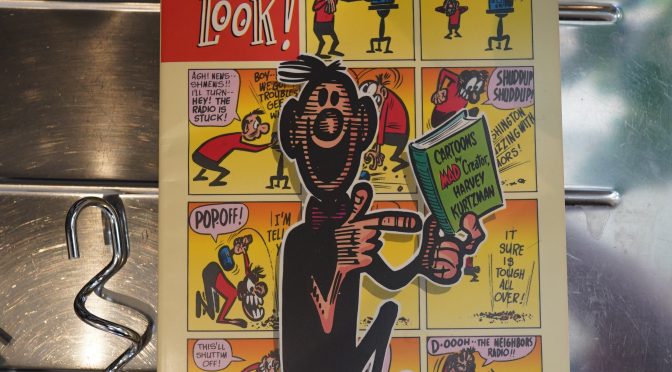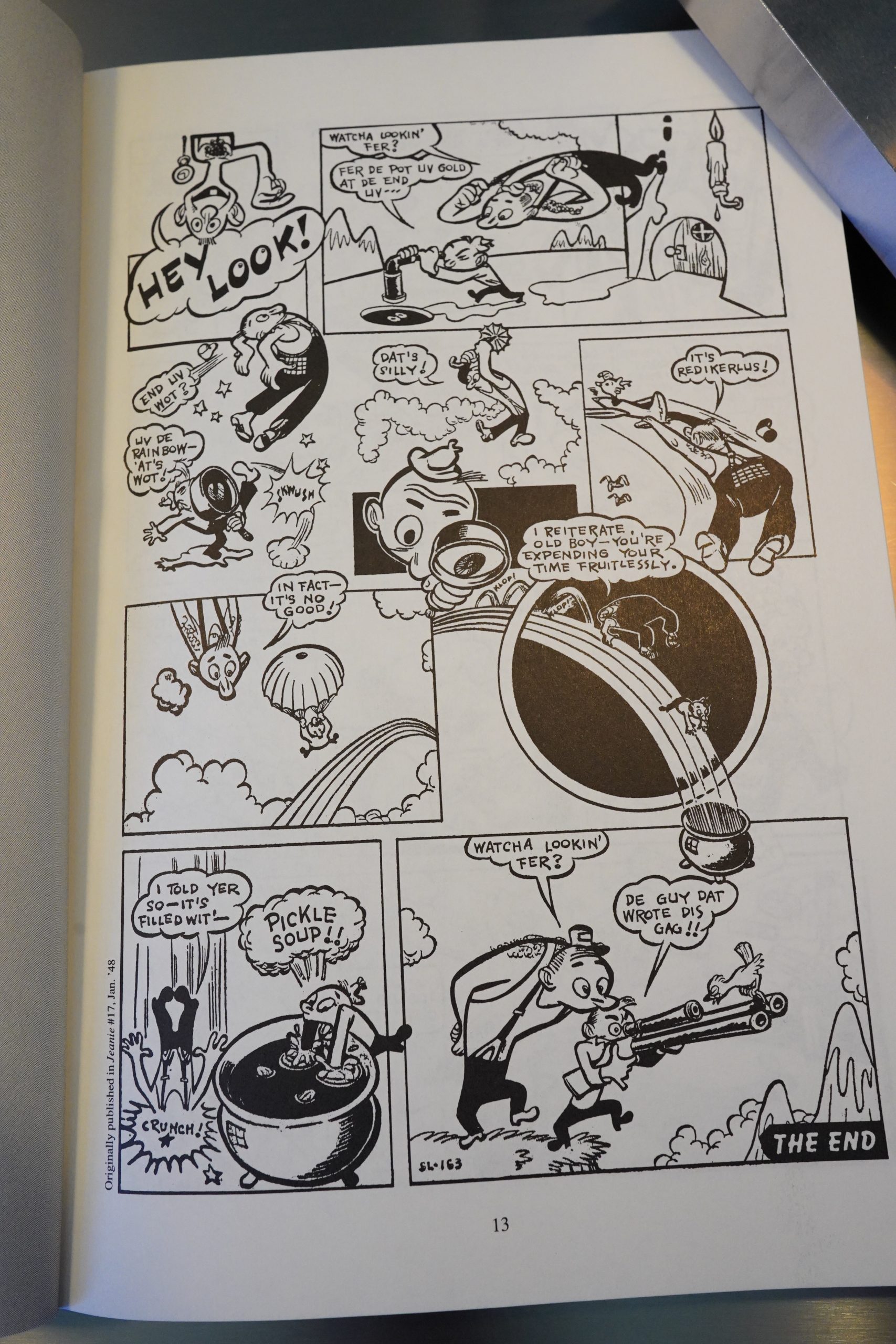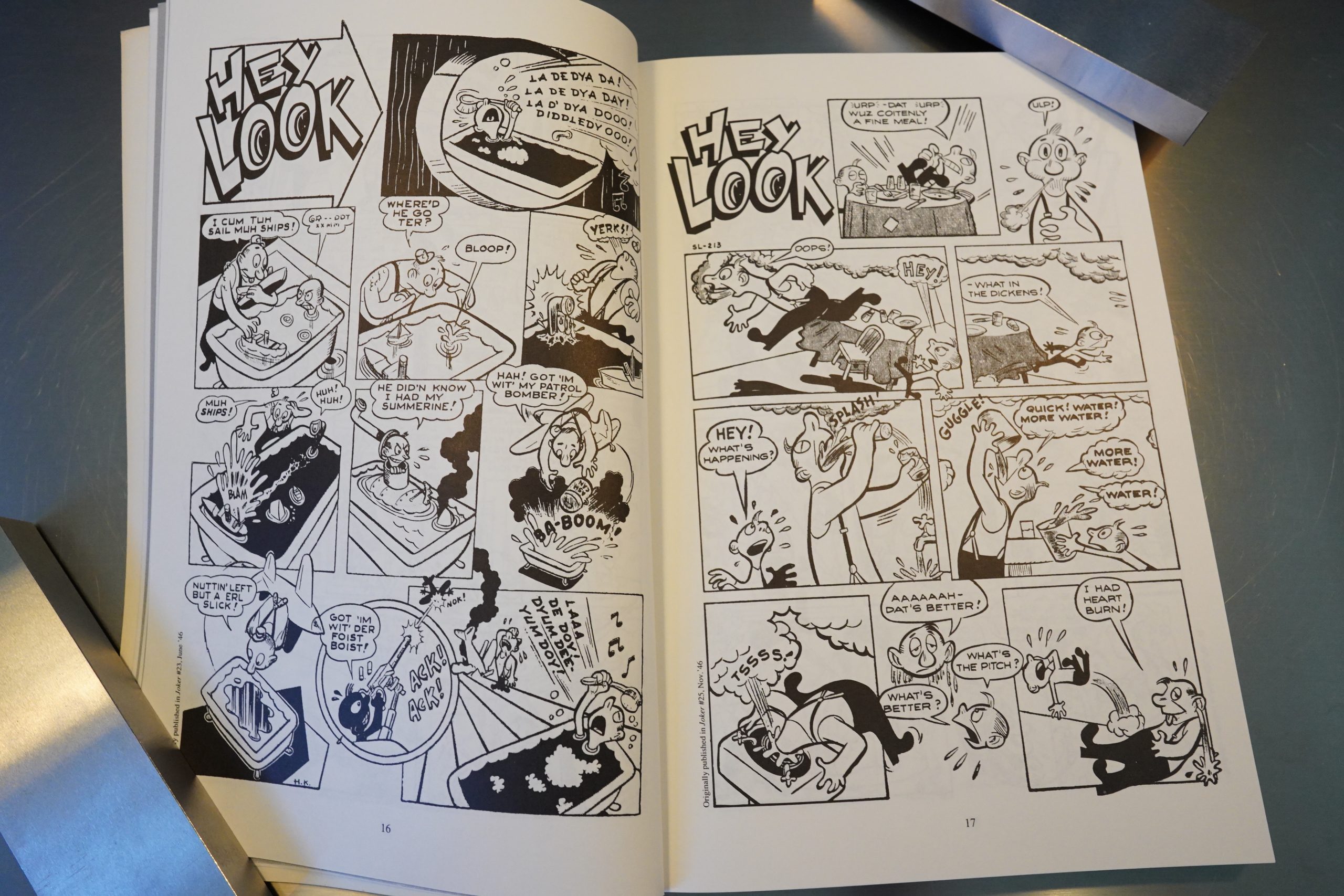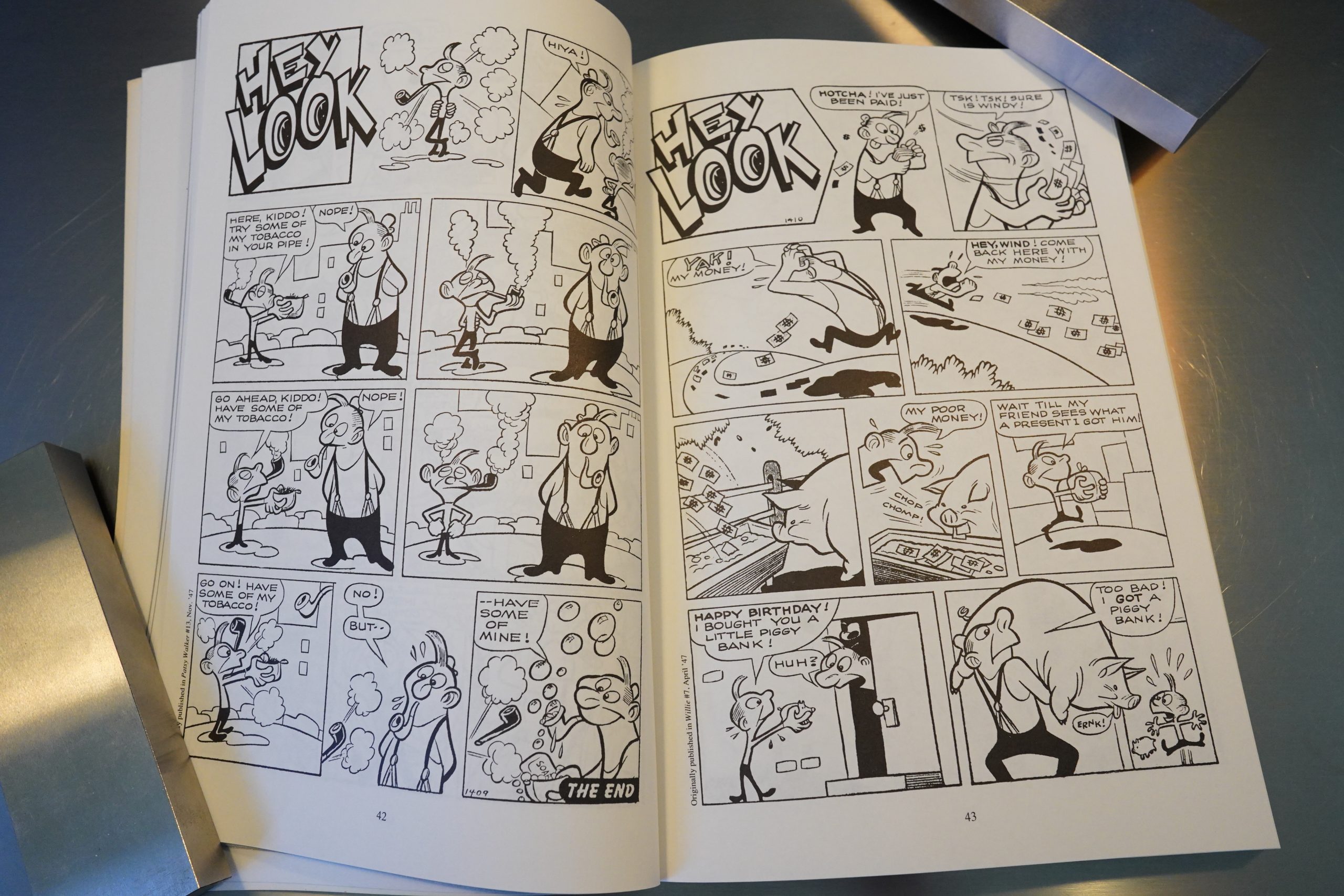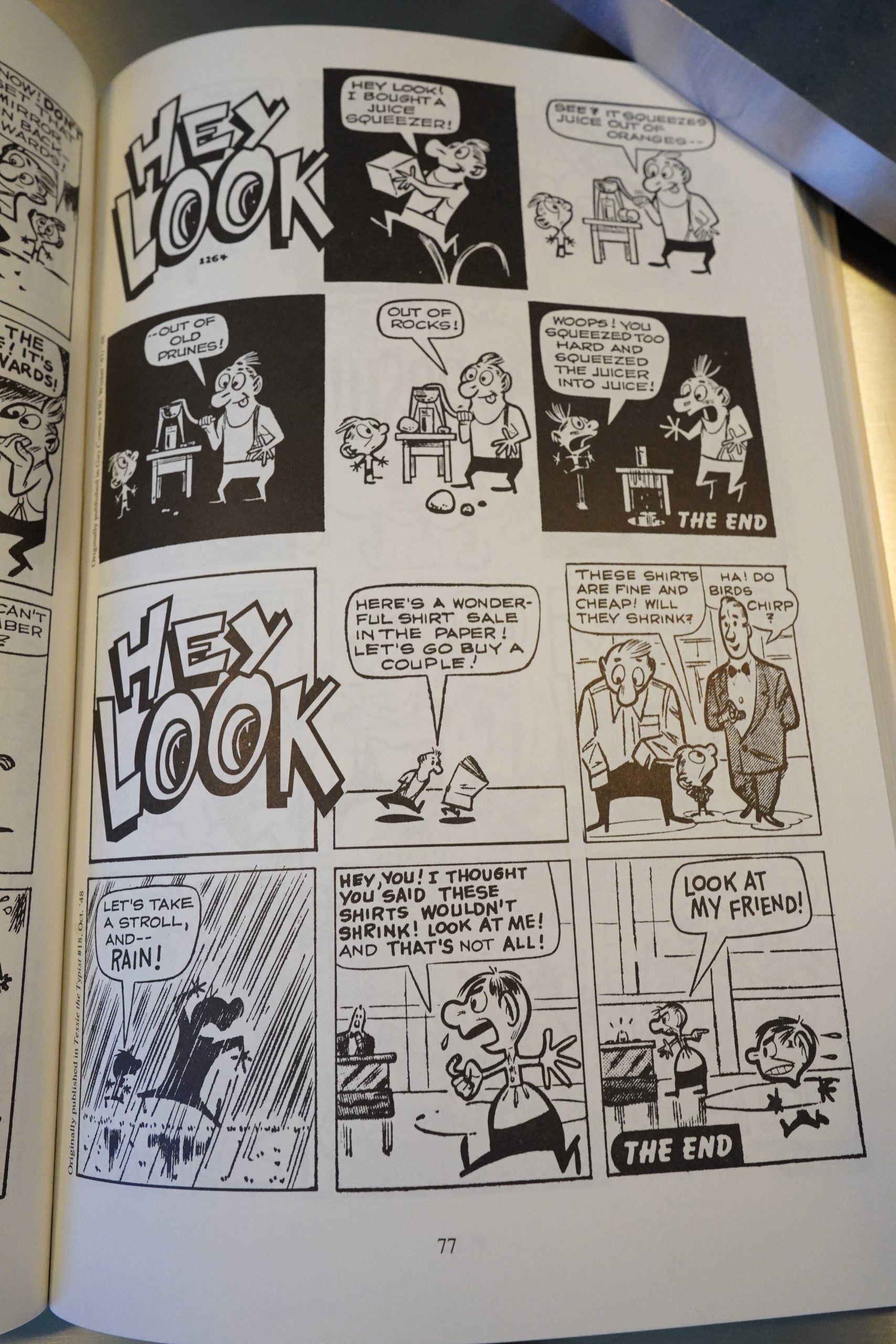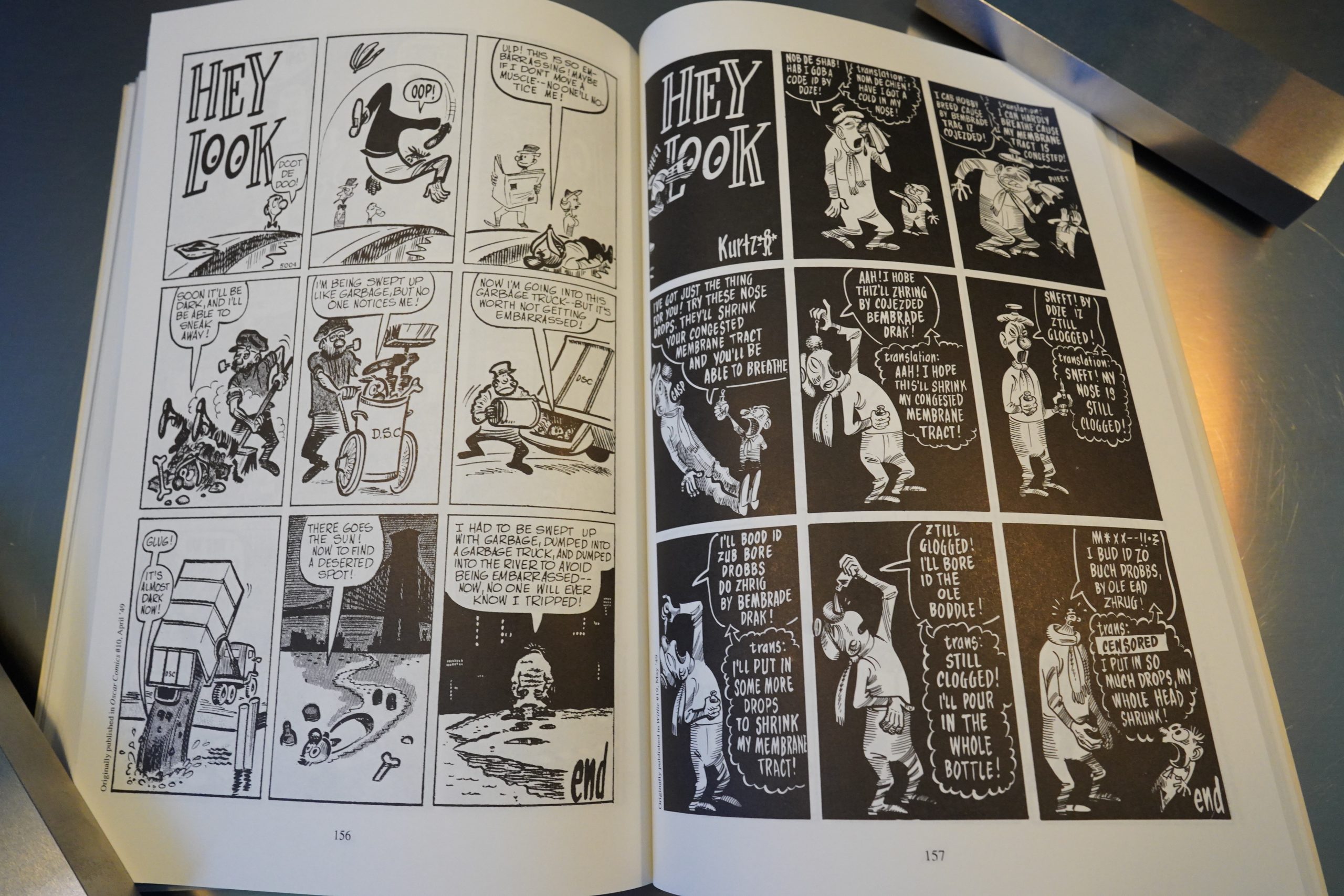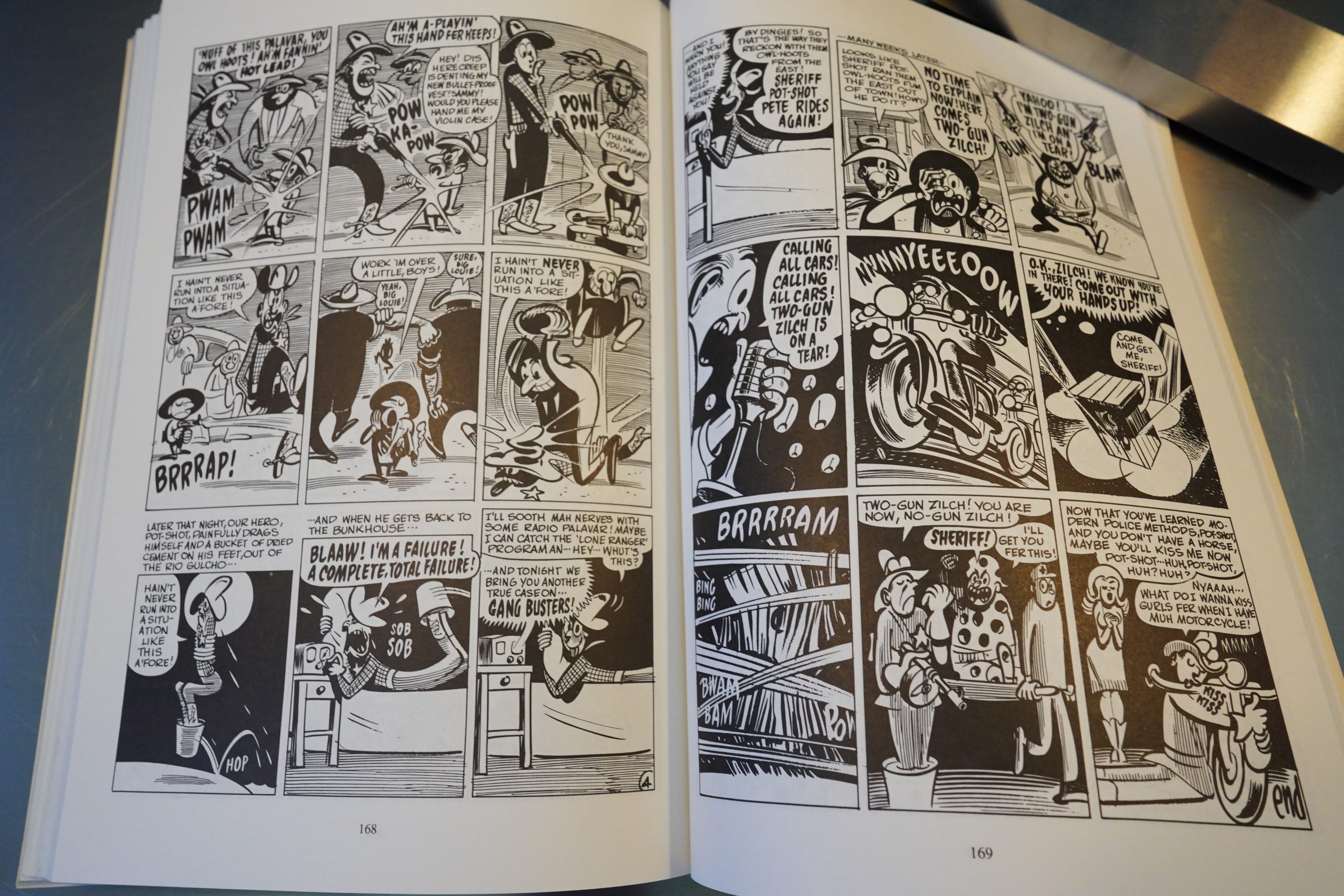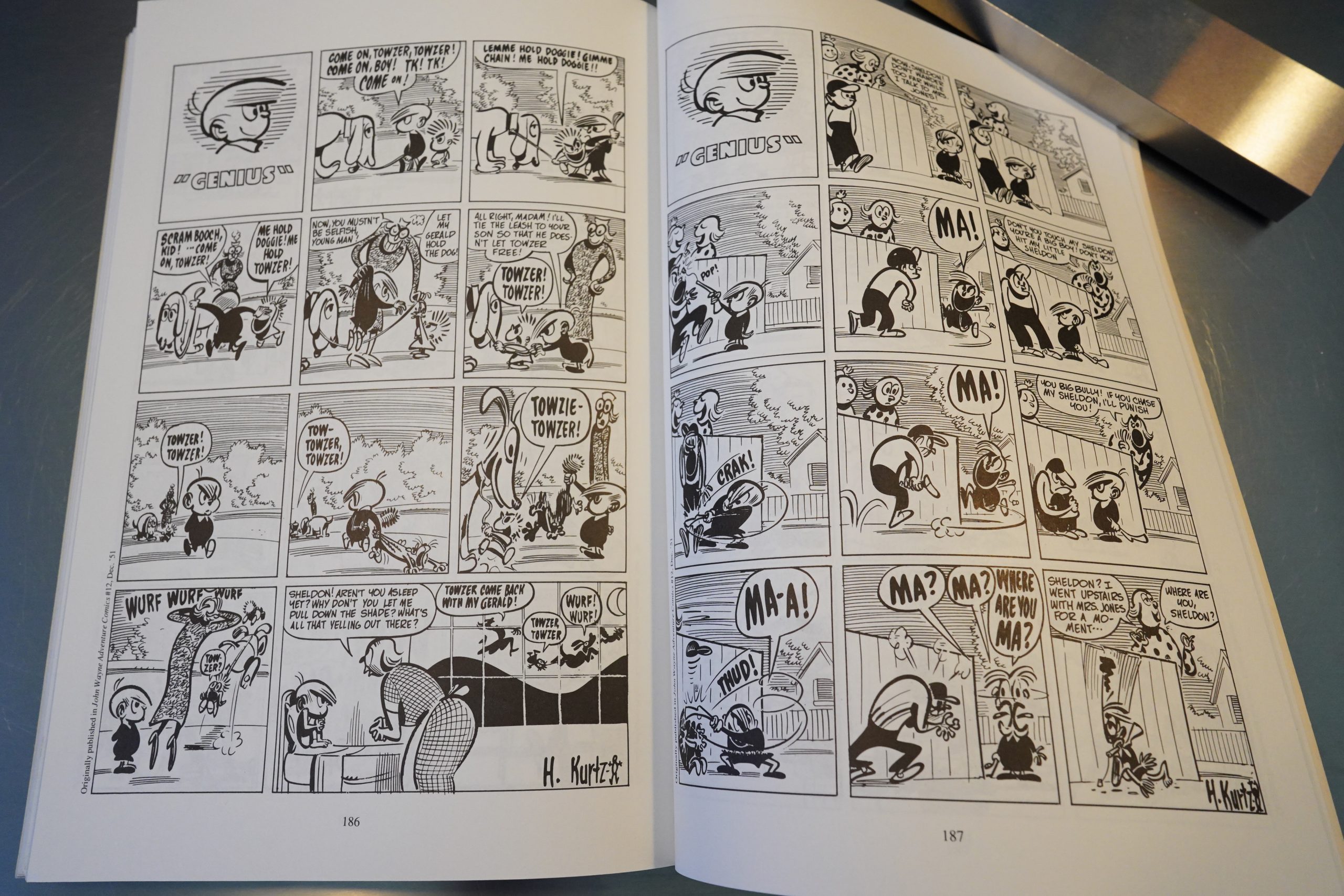Hey Look (1991) by Harvey Kurtzman
Kitchen Sink’s been publishing a lot of reprint collections in various formats, and some of them haven’t been quite ideal. This book feels just right, though — compact and satisfying, somehow, as an object.
People writing introductions (in those days) felt compelled to shovel it on with a trowel.
But it’s fun reading these early Kurtzman strips. Kurtzman hasn’t quite developed his line yes, and things look more influenced by animated cartoons than his artwork would later become.
The humour veers between over-the-top zany and goofy word play.
Sometimes the gags are pretty strained, but I guess he was on a deadline.
He doesn’t get meta all that much, but… this is pretty ingenious.
Kurtzman’s great at making things so absurd you just have to kind of go along with the gag.
Towards the end, Kurtzman’s mature style develops, with those thicker inky lines.
Anyway, I’m sure I’m not surprising anybody by claiming that the Hey Look strips are pretty amusing. Reading this many in one sitting, though, did not have a cumulative effect (you know, where things get funnier and funnier), and instead it’s rather wearying?
The book also collects some non Hey Look strips. Some are very Mad-like.
And some are more conventional.
The Comics Journal #151, page 113:
Harvey Kurtzman’s “Hey Look!” one-pagers, used
as filler in Timely (later Marvel) Comics’ cheesecake
and kiddie titles in the late 1940s, are fondly remem-
bered while the detritus they summed has lxrished
in obscurity. Gathering all the various issues of Nellie
the Nurse and Gay Comics (no relation to the current
title!). etc., to get these delightful, graphically exciting
strips is a feat beyond human ken, but the folks at
Kitchen Sink have done it. In these strips. produced
fmm 1946 to ’49. you can see Kurtzman finding him-
self as both a humorist and a cartoonist. The first
25-or-so episodes are teeming with klutzy gags and
stiff drawing. Towards the middle of “Hey Look!”
Kurtzman slips into first gear and plays wildly and
joyously with the conventions ofthe comics form. bu
can also see the satirist he’d soon become lurking in
the wings. The bmk’s designer. Monte (Blab!) Beau-
champ and his talented assistant, Dale Crain. have
done the t*St job rescuing rnany of thee strilh
from their atysmal original printings. Blessedly, most
of the later “Hey 1.00k! “s conne from crisp photostats.
as do the tx»ok’s backup features. which include the
very MAD-Iike \ÅCstern comedy Shot Pete” and
the less involving ‘Genius” and “Egghead Docxile,”
the latter barely recognizable Kurtzman’s work.
Stylishly packaged in a RAW-sized volume, The Com-
plete Hey Inok! is long overdue, offering a vast chunk
of Kurtzman’s undergraduate “Ork. Now somebody
needs to reprint the complete runs of Trump and Hum-
bug. Kurtzman’s post-MAD satire mags. Any takers?
Mark Barnette writes in The Comics Journal #153, page 46:
Kurtzman’s first published Hey Look! strips
are as reductive as early Ramones, peeling away
the non-essential elements of plot — leaving as
much as can be shoe-horned onto a single page
— and putting the strip and everything in it to
the service of the gag — which, admittedly, was
often pretty hoary.
Here in abundance are the familiar violence
and the peculiar visual codes of gag comics:
sweat marks popping out of characters’ heads,
the tipping over backwards to indicate surprise
or exasperation — the sine qua non of standard-
issue funnybooks. Understood by nearly every-
body, the product was therefore presumed to be
salable, even to the readers of Great Lover
Romance.
In a traditional comics device, Kurtzman
employs two characters, a big stupid guy and
a small short-tempered one (both nameless), in
almost every Hey 1.00k! strip. Sometimes the
big guy will violate some law of physics: sitting
on the ceiling or trying to drown himself while
wearing a water-repellent coat. Sometimes he’s
overly-literal, as when he brings a potted plant
to a palm reader or mixes up a deck of cards
with a Mix-Master. These shenanigans infuriate
the little guy, who can be seen tipping over,
sweat marks suspended, or bashing the big guy’s
head with the blunt side of an axe in the final
panel.
On the face of it, these early Hey look!
pages might be the ‘*Ork of any journeyman car-
toonist laboring in Lee’s employ at the time. But
there are enough suggestions Of what was to
issue later from Kurtzman’s fevered brain to be
found here that a more careful reading is re-
warded. Eventually — and especially if the
reader attempts to barrel through the book in
a single sitting — a rhythm asserts itself, and
the one-two punch of the strips becomes hyp-
notic. Punchlines reminiscent Of schoolyard
jokes — “I just remembered! I can’t swim!”
tap into something familiar and comfortable,
while bit by bit Kurtzman begins standing that
comfy tradition on its head.
Even the earliest strips toy with the notion
of the characters’ awareness of themselves as
inhabitants of a two-dimensional world.
“Deemed, destined and doomed to a comic
book existence — nothing but a two-dimensional
caricature of a life. I want to die!” says the big
guy in a strip in which he keeps bouncing back
onto the bridge from which he hurls himself,
thanks to his water-repellent jacket. The very
first Hey Inok!, in fact, ends with the short guy
gunning for “the guy dat wrote this gag!”
but Kurtzman wasn’t yet confident enough to
allow his handiwork to actually catch up to him.
Later strips, however, become more authorita-
tive. As his art became less beholden to comics
conventions, Kurtzman began his reconnais-
sance for an assault on the formalities of the
idiom — turning panels inside out, or allowing
his characters to communicate between different
episodes.[…]
In another strip (one that must have raised
some eyebrows at Timely), the two decide they’d
like to try “some regular adventure comics for
a change!” and become caped am] cowled super-
heroes, bouncing bullets Off their chests for fun
and indulging in little bit of sadistic violence”
— and some stock moralizing, too. In the end,
surrounded by corpses, up to their knees in
blood, nauseated, they decide to return to Hey
1130k! , where it’s back to business as usual.
“Ha!” says the little guy, “Nothing like good
clean funny comic fun! No blood! Nobody dies!
Nothing to clean up! Nothing!” — all the while,
of course, flattening his partner’s head with a
mallet.
Hey lnok:’ came to an abrupt end in 1949,
just as Kurtzman was hitting his stride. Accord-
ing to Benson, Timely assigned him to illustrate
a Blondie rip-off called Rusty. where he was ap-
parently let go for not copying Chic Young’s
style closely enough.
He continued to freelance, scraping by with
very unremarkable kid-strips, also included
in this volume; one for Lee called Egghead
Doodles (“That’s me!”), and the other for Elliot
Caplin at Tobey Press called Genius. But the
next step towards MAD and posterity was an-
other series for Caplin called Pot-Shot Pete,
which included three ambitious five-pagers —
two of which were assured enough to be later
reprinted in MAD.
This is the one hundred and twenty-ninth post in the Entire Kitchen Sink blog series.
